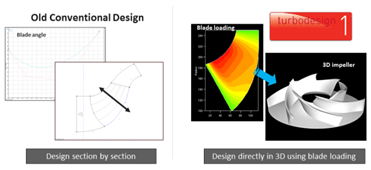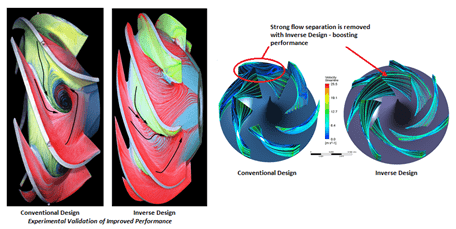The Inverse Design process, theory and application for the pump industry.
The Inverse Design process:
3D Inverse design is the process by which a 3D fluid-dynamic turbomachinery geometry is produced directly from the behavior the user wants the component (impeller, rotor, stator) to have on the flow – expressed using the fluid-dynamic blade loading (pressure distribution…).
Additional inputs are:
- The operating conditions (rpm, flow rate, head…)
- The meridional profile of the component and its required thicknes.
Inverse design (using TURBOdesign1) specifically focuses on 3D design by calculating a geometry directly from a required blade loading

Theory
Inverse design (using TURBOdesign1) specifically focuses on 3D design by calculating a geometry directly from a required blade loadingTheory
The background theory for 3D Inverse Design emerged from W. Hawthorne's (1984) classical aerodynamic approach of representing the blade by a bound sheet of vorticity, whose strength is determined by a specified distribution of circumferentially averaged swirl velocity. The approach developed by M. Zangeneh (1991) and commercialised by ADT builds on the relationship between the pressure difference at any location and the derivative of circumferentially averaged swirl velocity over meridional distance. For a specified blade thickness, the algorithm is then able to define a surface direction from the velocity tangentiality condition, which generates the blade shape.
Further applications and deeper explanation of the theory can be found among our Publications.
Comparisons demonstrating the advantages of Inverse Design over the conventional method

Benefits to Pump design
The use of blade loading to drive the design process enables engineers and designers to control the flow physics directly and tailor the effect of the component on the flow. Particular loading profiles are used to:
- Minimise losses;
- Reduce or prevent cavitation;
- Minimise secondary flows and improve flow uniformity;
- Achieve more compact designs, which are cheaper to manufacture and install.
TURBOdesign Suite gives engineers and designers a toolset with which to rapidly design and optimise pump components, producing market-leading designs that are consistently shown to significantly outperform conventional designs in terms of head, efficiency and range.
Download our paper on Performance Optimization of Centrifugal Pump Stage with the 3D Inverse Design Method to learn more about the process.



Share This Post